This post may contain affiliate links.
Regarded as one of the best beginner Cichlids, Electric Blue Acara are easy-to-keep fish that make an ideal fit for newcomers venturing into Cichlid tanks. If you got a display aquarium and looking for a centerpiece fish, you can’t go wrong with these captivating South American Cichlids boasting a vibrant blue coloration.
Whether you are a seasoned pro or a newbie planning to bring home some Electric Blue Acara, this article is for you. The following is an all-encompassing guide consisting of the nitty-gritty of setting up and maintaining an Electric Blue Acara tank, including what to feed them and how to choose tankmates. Moreover, you will learn about the common ailments of Electric Blue Acara and the breeding of these beautiful community fish.
Get To Know Your Fish – The Electric Blue Acara
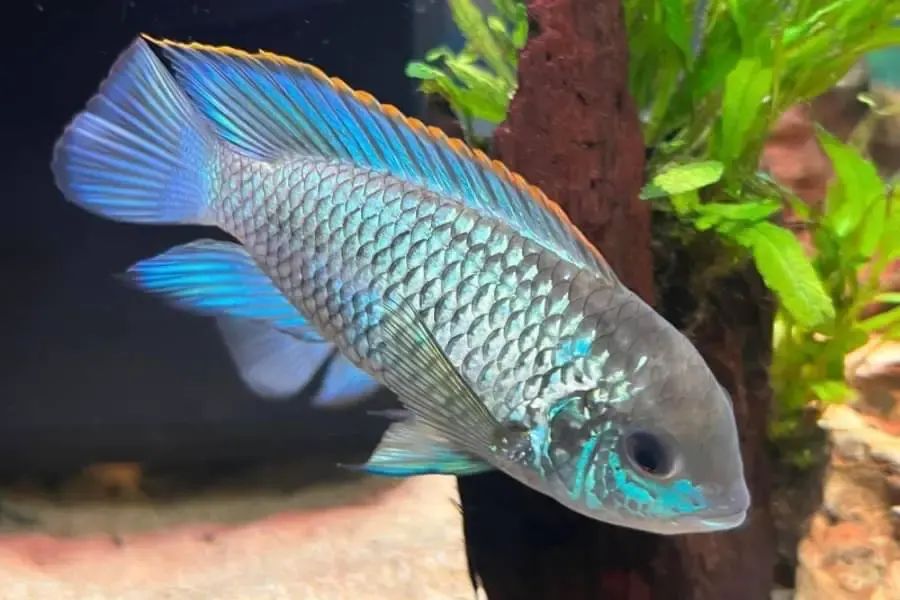
If you are new to Electric Blue Acara, you might want to know these things before stocking the tank:
Where Do They Come From?
Electric Blue Acara is not a naturally occurring fish. A popular theory suggests they were created by hybridizing ordinary Blue Acara and Blue Rams. Then there is a counter-argumentative theory that states Electric Blue Acara is a result of line-bred mutation.
However, no scientific studies or DNA reports are available to prove whether genetic modification or crossbreeding gave rise to these strikingly beautiful fish.
How Big Do They Get?
Electric Blue Acara are moderately-sized fish that can grow up to 6 to 7 inches. Usually, males are slightly larger and have an elongated dorsal fin than females. These fish are slow growers and take a few years to be full-grown.
How Long Do They Live?
On Average, you can expect an Electric Blue Acara to live around 7 to 10 years.
Remember, the lifespan of a fish is significantly impacted by its living conditions and the diet given.
Are They Beginners Friendly?
Absolutely! The Electric Blue Acara is a hardy fish and needs nothing more than basic Cichlid care.
They can adapt to various environmental conditions and water parameters, allowing wiggle room for the newbies to not be up to the mark at all times and still have a thriving aquarium.
The best part? Electric Blue Acara aren’t picky eaters and will eat anything you give them.
Are Electric Blue Acara Aggressive?
For a Cichlid’s temperament, Electric Blue Acara is a laid-back and mellow fish. They are often labeled semi-aggressive due to their ability to cause aggression when required or asked for.
Usually, the aggressive mode of Electric Blue Acara is manifested during spawning or when pressed by aggressive tankmates.
In a peaceful environment, Electric Blue Acara get along well with one another, and owing to their passive demeanor, make an ideal choice for a community tank.
Setting Up & Maintaining an Electric Blue Acara Aquarium
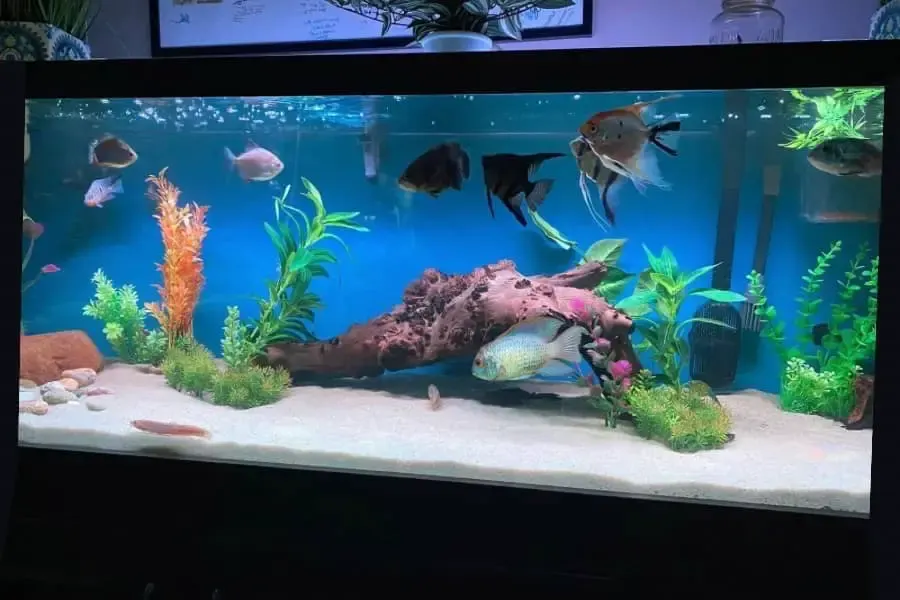
Setting up a tank doesn’t have to be complicated, even if you are a newcomer to the hobby. It’s laughably easy when you know how to do it the right way and which the subsequent sections are all about.
What Tank Size Does an Electric Blue Acara Need?
Getting an adequate-sized aquarium is essential as it’s the foundation of your living ecosystem.
Electric Blue Acara can reach up to 6 to 7 inches and are active swimmers who enjoy space, so you need at least a 30-gallon aquarium for a single adult.
If you are going to keep a pair, a 40-gallon tank would be a perfect choice. It can easily house the male and female fish, including the fry population, for the time they require parental care.
If you want a pair of Electric Blue Acara in a community tank with other species, go for a 55 or 77-gallon aquarium or even bigger, depending on the size and the number of fish you want to accommodate,
Ideally, the larger you go, the happier your fish will be and the less water quality issues you’ll have to deal with.
NOTE: Never compromise on the size of your aquarium unless you are a cruel person who would entertain the idea of cramping a voiceless aquatic animal in a small box. No pun intended!
Favorable Water Parameters For Electric Blue Acara
As previously mentioned, Electric Blue Acara is a hardy fish that can handle a wide range of water parameters and most (liveable) aquarium conditions.
Being a South American Cichlid, EBAs prefer tropical temperatures and soft, acidic to slightly alkaline water.
- Temperature: 23–30°C or 73–86°F
- pH levels: 6.0 to 7.2
- Water hardness: can tolerate any hardness level below 12 KH. But it’s best to keep it at a moderate range of 5-7 degrees.
NOTE: You don’t have to chase water parameters trying to keep them at a particular point; just aim to keep them consistent. No matter how hardy a fish is, constant fluctuations are never welcomed.
How To Properly Maintain an Electric Blue Acara Aquarium?
Setting up an aquascape and stocking fish is only a part of it. You must learn to care for your aquarium to keep it in optimal condition.
Filtration: Electric Blue Acara doesn’t have any specific filtration requirements. You can get a hang-on-the-back filter or canister filter rated for your tank’s capacity (preferably higher) to ensure adequate filtration.
Water Changes: The routine act of removing a certain amount of aquarium water and replacing it with fresh water is of paramount importance.
How often and how much water you need to change will depend on the amount of nitrates being produced in your tank. The aim is to keep it below 40 ppm – a safe range for most fish, including Electric Blue Acara.
Excessive nitrate levels are often a result of a higher bioload that consists of fish poop, leftover food, and other rotting organics.
Since every tank has a different bioload, no one-size-fits-all water-changing schedule exists. To evaluate your ‘very own’ water-changing frequency, you have to test your aquarium for nitrates.
For instance, if your aquarium produces 10 ppm of nitrates a week, in 4 weeks, it will ramp up to 40 ppm. Remember, we can’t let it go any higher than this, as we are sitting tightly on the verge of entering the unsafe nitrate range.
So, if you make an immediate 30% water change, the nitrates will be reduced to 28 ppm. As another week pass by, your fish will have produced 10 ppm of nitrates, bringing back the count to 38 ppm.
As you can see with these numbers, you will be required to perform a 30% water change every week. Likewise, you can determine a water-changing schedule tailored for your Electric Blue Acara tank.
Substrate Cleaning: As a part of regular tank maintenance, every once in a while or during a water change, the substrate should be vacuumed to remove uneaten food and other organic waste that might have accumulated onto the bed.
What Does Electric Blue Acara Like In Their Tank?
- Almost all Cichlids love to dig in the sand. Some even borrow pits during the breeding season. Considering all that, it would be best to provide your Electric Blue Acara with a sandy substrate to play around and have fun.
- You can also get some driftwood pieces, rocks, and plants to mimic a natural habitat. These decor items help create hiding spots for your fish to take refuge when required. However, before placing any solid objects in your tank, ensure they don’t have sharp edges.
Although there is no limitation on the decorations, it is always wise to have fewer items, especially when you have a bare minimum tank size. Taking away the swimming space of your fish is not virtuous.
Are Electric Blue Acara Plants Safe?
Generally, Electric Blue Acara isn’t considered a plant demolisher. Only during the breeding period can these fish be seen digging substrate or uprooting plants. How much destruction your EBA may cause will depend on the individual’s demeanor.
Live plants (mainly the small ones) planted on the substrate are easily uprooted when confronted and shaken by an aggressive Cichlid. And for that reason, specifically, many fish keepers choose to keep floating plants in their aquariums.
Some of the best heartier plants that make up a perfect tank setup include:
- Anubias spp.
- Java fern (Leptochilus pteropus)
- Java moss (Vesicularia dubyana)
- Water sprite (Ceratopteris thalictroides)
- Hornwort (Ceratophyllum demersum)
- Duckweed (Lemna spp.)
- Guppy Grass (Najas guadalupensis)
The bottom line is you can have a thriving planted aquarium with Electric Blue Acara if you don’t mind occasionally digging.
What To Feed Electric Blue Acara?
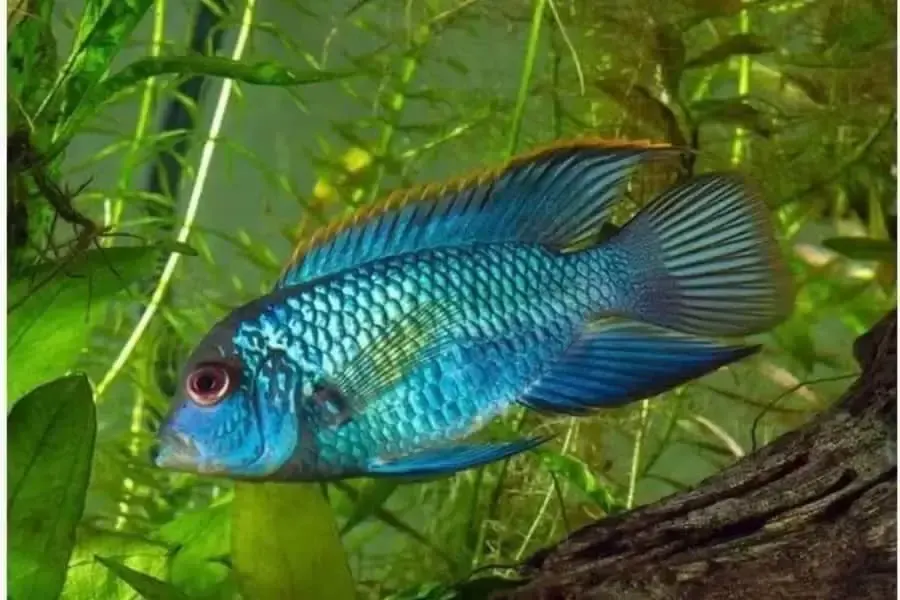
Technically, Electric Blue Acara are omnivores. But in captivity, they come out as more of a carnivorous fish than omnivores.
However, the best part is these South American Cichlids aren’t picky, which makes it relatively easy to feed them.
A nutritionally balanced, varied diet is essential to raise a healthy Electric Blue Acara and bring forth its best colors. It includes feeding high-quality pellets or flakes and occasionally tossing in some live or frozen foods such as bloodworms or brine shrimp.
Feeding a variety of food helps fish grow faster while fulfilling most of their dietary or nutritional requirements.
How Much and How Often To Feed?
An adult Electric Blue Acara should be fed once or twice a day. Growing babies need to be given three to five small meals daily.
If you are wondering how much food to give, it will depend on the size of your fish.
You might have heard varying opinions on what makes the adequate amount of food for a fish – some say that a fish should be offered enough food it can finish in a minute, while some fishkeepers insist on feeding as much as a fish can eat in 5 minutes.
As you can see, the difference is 5x. It’s because some fish are fast eaters, and others are exceptionally slow. If you apply a general guideline to your Electric Blue Acara, you might end up either overfeeding your fish or leaving the poor little creature underfed and starving.
Out of all, a better way to gauge the appropriate portion size for your fish is by observing the roundness of its belly from both top and side views. Let your Electric Blue Araca eat enough food until it has a slightly rounded abdomen.
You may have to try different portions to find out how much food it takes for your fish to be well-fed. However, if you apply this technique, you must be careful not to overfeed your fish.
Sings of overfeeding: swollen belly, too much poop, an abundance of uneaten food, and cloudy water.
Sings of underfeeding: often times in an attempt to avoid the risk of overfeeding, we end up starving our pets, which usually manifest as skinny bodies or sunken bellies.
How To Choose Tankmates for Electric Blue Acara?
Despite coming from the family of Cichlids, EBAs are not overly aggressive but rather adaptive, which allows aquarists to keep them with an assortment of tank mates.
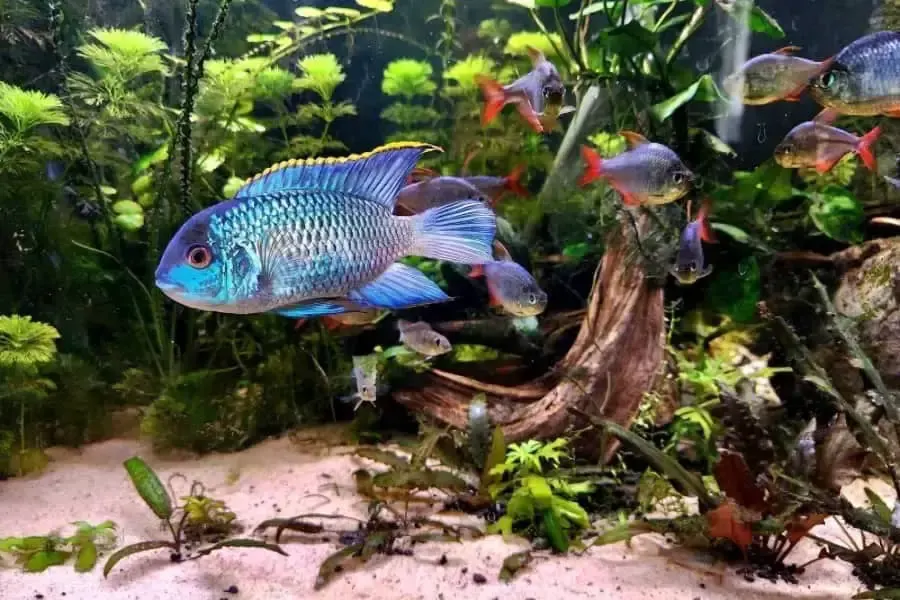
Electric Blue Acara and Tinfoil Barbs
Even though Electric Blue Acara are relatively peaceful fish, they are still Cichlid and will not hesitate to go for anything that fits their mouth.
Smaller, narrow-bodied fish like tetras, corries, or small invertebrates, like dwarf shrimp and snails, will probably get eaten if kept along with Electric Blues.
Best Tankmates To Keep With Electric Blue Acara In a Community Tank
- If you are planning a South American Cichlid tank setup, go for Severum and Geophagus. You will absolutely love the trio. The best part? They don’t require a giant aquarium.
- Some mid-size to larger Tetras include Columbian Tetra, Congo Tetra, Emperor Tetra, Black Phantom Tetra, Black and White Skirt Tetra.
- Electric Blue Acara can also go with Barbs, including Denison barbs, Silver Dollars, Bala Shark, and Tin Foil barbs. To accommodate these fish, you will require a pretty big tank.
- If you want a Cichlid-only tank, you can go for peaceful Cichlids such as Angelfish, Keyhole, Apistogramma, or Rams. However, if you’re going to keep EBAs with aggressive species such as the Oscars, Jack Dempsey, Convict, and Firemouth, take caution.
- Electric Blue Acara can also be kept along bottom dwellers such as Clown Loaches, Plecos, and Corydoras.
- If you want a color combination that fits with Electric Blue Acara best, you should stock some Rainbow Fish and Corey Cats.
NOTE: EBAs, when placed with aggressive species, will be able to hold their own. If you are keeping aggressive Cichlids together, assigning them a larger tank would be wise, as it will increase your chances of success.
How to Bring Out The Best Colors of Electric Blue Acara?
To naturally enhance the color of your Electric Blue Acra, all you need to do is:
- Feed a healthy diet: it includes high-quality pellets/flakes with occasional treats like frozen bloodworms, krill, or mysis shrimp.
- Keep the water clean: regularly clean your filter to ensure it’s working efficiently, carry out weekly water changes, and make it a habit to remove leftover food as soon as your fish eats his meal.
- Ensure an stress-free environment: stress not only affects your fish’s health but also causes subdued coloration. Major environmental stressors include high ammonia/nitrite, overcrowding, aggression, and significant fluctuations in water parameters.
Besides providing your fish with favorable living conditions, the theme of your aquaspace and color scheme also plays a vital role in enabling the fish to showcase its best, brightest colors.
- Dark substrate and background: keep the substrate and background dark to bring your Electric blues color popping. For instance, you can try dark black sand or gravel with a black background.
- Good lighting: it goes without saying that having a decent lighting setup helps to enrich the color of the fish, making them stand out.
- Plants coverage: you don’t necessarily need plants, but having a backdrop of green enables the Electric Blue Acara to display vivid colors.
Common Diseases of Electric Blue Acara – Causes, Symptoms & Remedies
If you are going to bring home EBAs, you must take the time to get familiar with ailments that commonly affect these fish. It will help you timely intervene, preventing the disease from progressing.
Ich or White Spot Disease
Ich or Ick is an external parasite that attaches to the fish’s body, gills, and fins, causing several white spots.
Symptoms:
- Ich manifests as tiny crystals on the body like someone has sprinkled salt on your fish.
- Fish rubbing/scratching its body against surfaces
- Rapid breathing
- Loss of appetite
- Loss of color
- Lethargy
- Exhibiting hiding behavior
Causes:
- Ichthyophthirius multifiliis protozoan is responsible for the condition.
Treatment:
- Using a heater and thermometer, crank the aquarium water temperature to 84-86 F. And maintain it for at least two weeks.
- Increasing the temperature will result in low oxygen levels. To compensate for this loss, place an air stone in your tank.
- Add some salt to your tank. Salt treatment is not suggested for planted tanks.
- Treat your aquarium using Ich-X, an effective medication for eliminating the parasite.
- Keep up with the water changes and substrate vacuuming.
Skin and Gill Flukes
Flukes are monogenetic trematodes, a common aquarium pest that mainly affects cichlids and feeds on mucus, skin, and occasionally blood.
Symptoms:
- Excessive mucus secretion
- Swollen and pale gills
- Spread opercula
- Breathing difficulty; gasping near the surface
- Flashing or rubbing against objects
- Clamped fins
- Loss of appetite
Treatment:
- Flukes thrive in poor water conditions. Therefore, the first step to treat this condition is to give your aquarium a good maintenance season, including a 50% water change, scraping the inside glass, siphoning the substrate, and cleaning filter media.
- Salt treatment is quite effective against fish flukes. Add four ounces of salt per ten gallons of water, and maintain it over three weeks.
- Formalin and commercial formalin/malachite green combinations are also used to combat gill flukes.
Breeding Electric Blue Acara The Pro Way
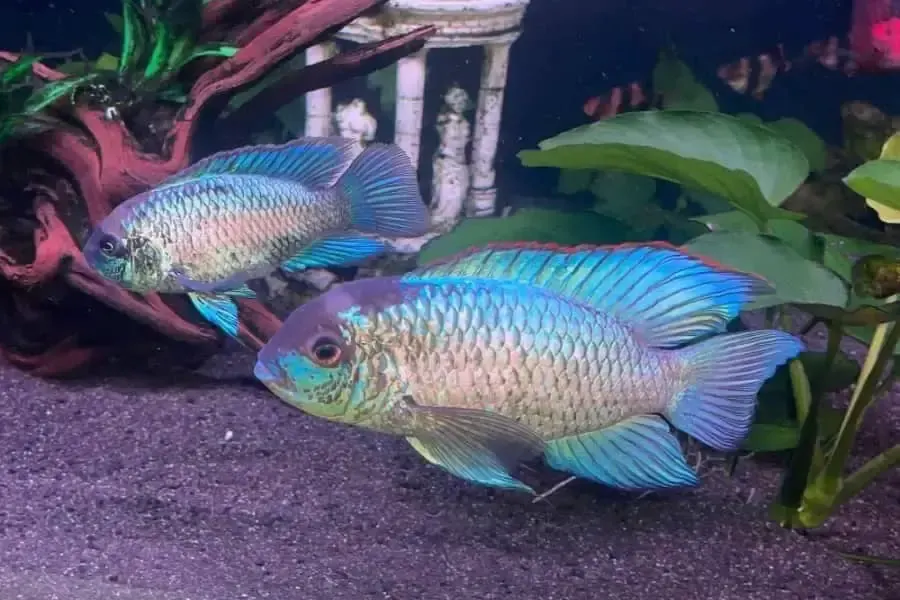
So, you want to breed the beautiful EBAs but don’t know where to start. Follow these steps, and you shall not hit a snag:
Step 1: Get a breeding pair
- Sometimes it can be challenging to distinguish between male and female fish. Therefore, it is best to buy a group of 6 Electric Blue Acara and let them naturally pair up.
- Usually, males have larger and slender bodies boasting longer and more pointed dorsal fins than females.
Step 2: Provide optimal conditions for spawning
- Once the pair has formed (you will know when it does), relocate it to a separate 40-gallon breeder or larger.
- Test the water to make sure the parameters are tailored to the Electric Blue Acara requirements (for reference, check the ‘favorable water parameters’ section shared above).
- Females lay eggs on rocks or sometimes even on driftwood, usually on a flat surface. If your tank has nothing like that, arrange one and put it in.
- Once the eggs are laid, the male will fertilize them. And both parents will guard their assets very aggressively.
- The eggs will hatch in 2 to 3 days. Initially, you will see little wigglers that will soon become a fry cloud.
Step 3: Move frys to a grow-out tank
- If you don’t want the parent fish to predate on their young ones, scoop the fries out to a grow-out tank or move the pair to their own tank.
- You can use a net, a turkey baster, or a siphon to remove the baby fish.
Step 4: Feed the babies well
- Food options for fries include freshly hatched baby brine shrimp, egg yolk, golden pearls, and/or finely crushed pellets/flakes.
- You need to feed them tiny meals 3 to 5 times a day with 50% water changes 2 to 3 times per week.
Frequently Asked Questions
Can you keep a single Electric Blue Acara?
EBAs don’t strictly fall under the category of schooling fish, but they prefer to be in the company of their own kind and are often observed thriving in groups. For that reason, keeping an Electric Blue Acara alone is not suggested.
How many Electric Blue Acara to keep together?
A group of 6 or 8 works best. You can keep more, given that you have a sizable tank.
Can Electric Blue Acara be kept with small tetras?
As EBAs grow bigger, smaller fish become their food.
Conclusion
So here we are on the verge of wrapping up this comprehensive guide detailing the Electric Blue Acara tank setup and maintenance.
If you are still with us, by now, you should’ve absorbed enough knowledge that you don’t need to read another article to get started with your first EBA aquarium.
